Project Management Project: Analyzing Project Success Factors
VerifiedAdded on 2021/06/17
|17
|4442
|74
Project
AI Summary
This project management assignment delves into the core principles and practices essential for successful project delivery. The paper begins by highlighting the modern role of project management in driving internal and external change, emphasizing its ability to enable competitive advantages and deliver commercial improvements. It then explores the significance of project scope, including key considerations during the conceptualization stage, the importance of a well-written project charter, and the alignment of cost, timeline, and quality components with strategic organizational goals. The assignment further examines cost and budget planning, emphasizing the need for a thorough understanding of the project lifecycle and the use of tools and techniques for breaking projects into manageable milestones. Effective team management is also addressed, focusing on identifying and allocating roles, fostering high-performance teams, and resolving conflicts. Finally, the paper underscores the importance of project control, measurement, and monitoring to ensure project success, including stakeholder management through effective reporting and communication. The assignment provides a comprehensive overview of project management principles and practices, offering insights into the factors that contribute to successful project outcomes.
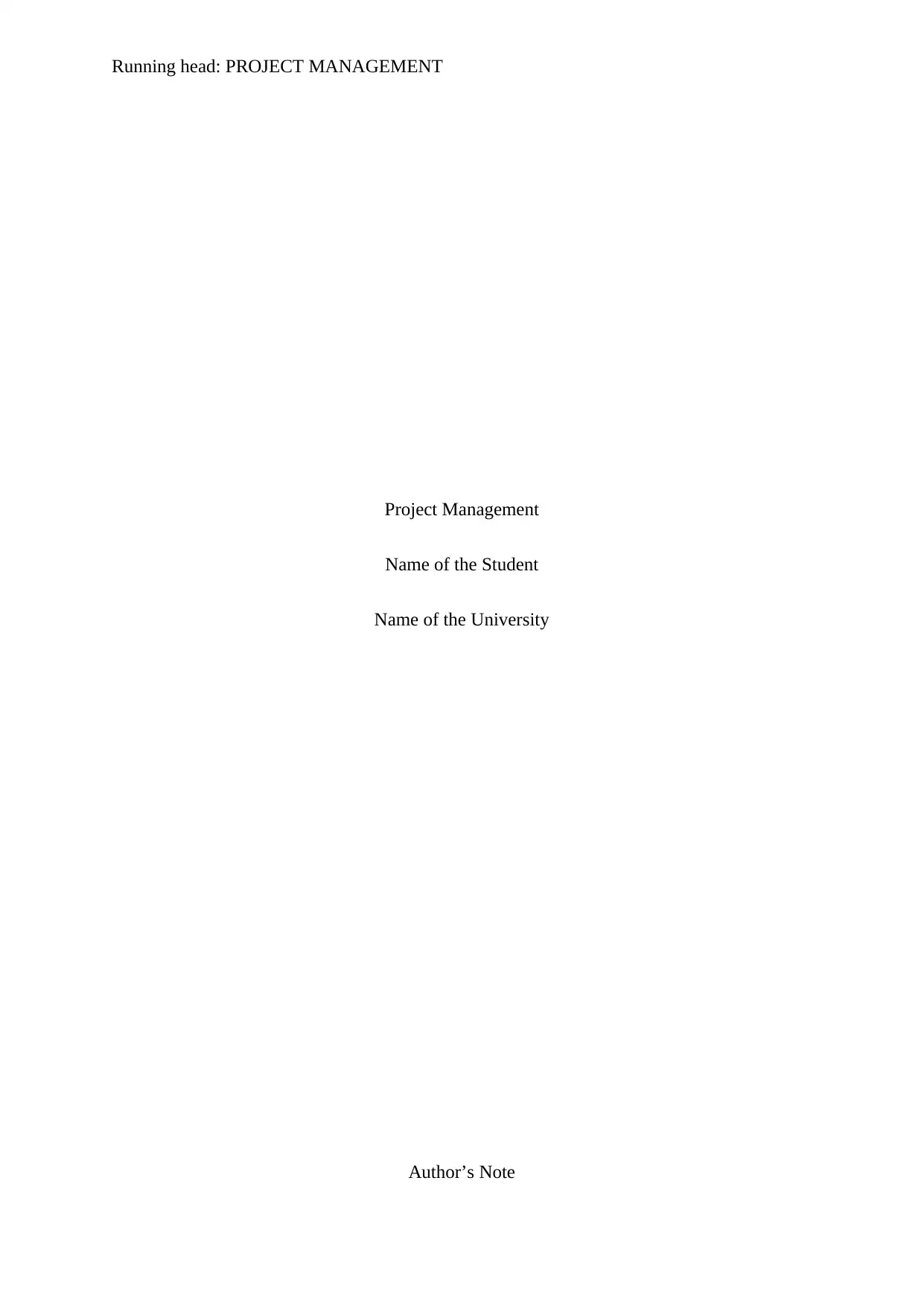
Running head: PROJECT MANAGEMENT
Project Management
Name of the Student
Name of the University
Author’s Note
Project Management
Name of the Student
Name of the University
Author’s Note
Paraphrase This Document
Need a fresh take? Get an instant paraphrase of this document with our AI Paraphraser
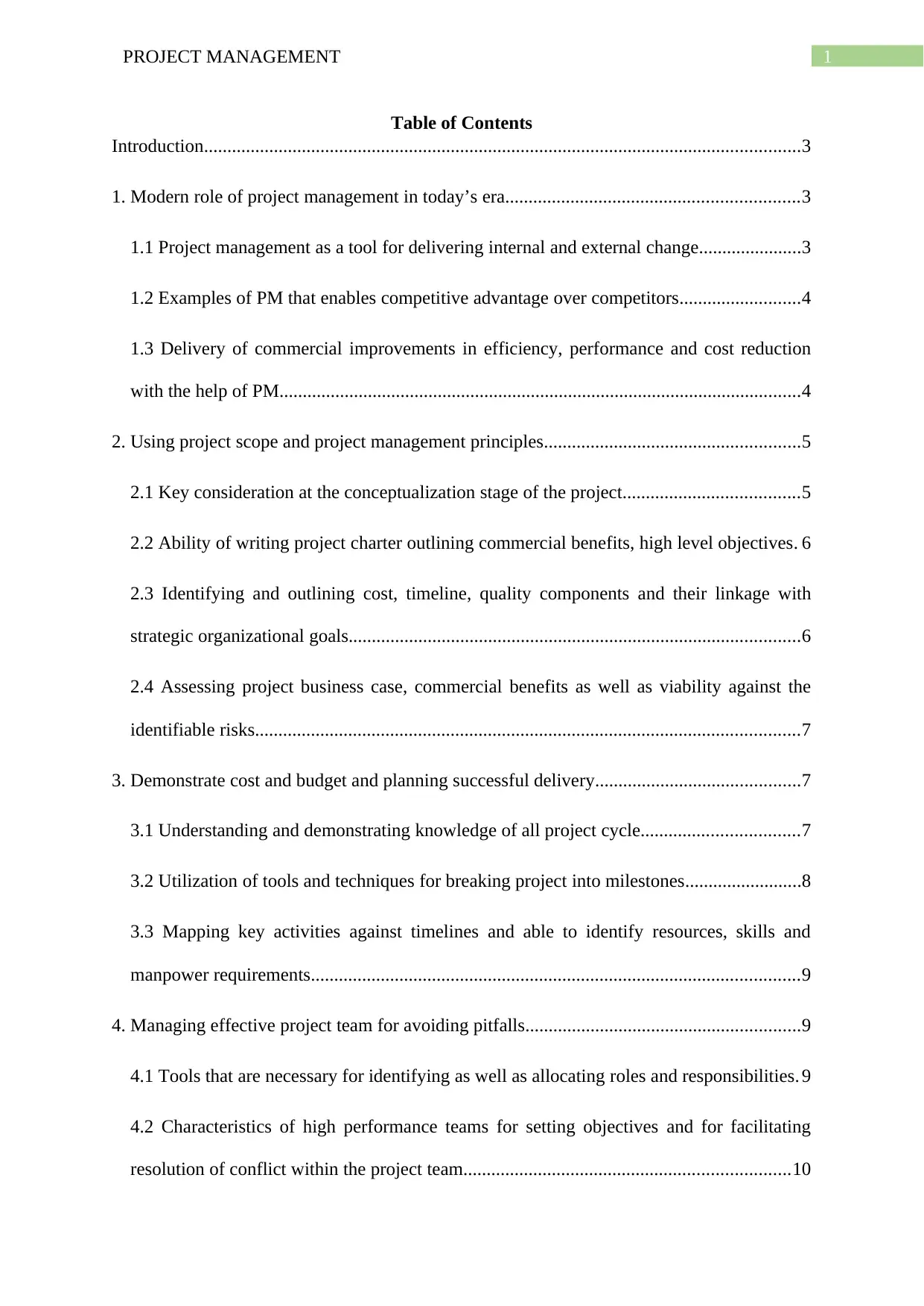
1PROJECT MANAGEMENT
Table of Contents
Introduction................................................................................................................................3
1. Modern role of project management in today’s era...............................................................3
1.1 Project management as a tool for delivering internal and external change......................3
1.2 Examples of PM that enables competitive advantage over competitors..........................4
1.3 Delivery of commercial improvements in efficiency, performance and cost reduction
with the help of PM................................................................................................................4
2. Using project scope and project management principles.......................................................5
2.1 Key consideration at the conceptualization stage of the project......................................5
2.2 Ability of writing project charter outlining commercial benefits, high level objectives. 6
2.3 Identifying and outlining cost, timeline, quality components and their linkage with
strategic organizational goals.................................................................................................6
2.4 Assessing project business case, commercial benefits as well as viability against the
identifiable risks.....................................................................................................................7
3. Demonstrate cost and budget and planning successful delivery............................................7
3.1 Understanding and demonstrating knowledge of all project cycle..................................7
3.2 Utilization of tools and techniques for breaking project into milestones.........................8
3.3 Mapping key activities against timelines and able to identify resources, skills and
manpower requirements.........................................................................................................9
4. Managing effective project team for avoiding pitfalls...........................................................9
4.1 Tools that are necessary for identifying as well as allocating roles and responsibilities. 9
4.2 Characteristics of high performance teams for setting objectives and for facilitating
resolution of conflict within the project team......................................................................10
Table of Contents
Introduction................................................................................................................................3
1. Modern role of project management in today’s era...............................................................3
1.1 Project management as a tool for delivering internal and external change......................3
1.2 Examples of PM that enables competitive advantage over competitors..........................4
1.3 Delivery of commercial improvements in efficiency, performance and cost reduction
with the help of PM................................................................................................................4
2. Using project scope and project management principles.......................................................5
2.1 Key consideration at the conceptualization stage of the project......................................5
2.2 Ability of writing project charter outlining commercial benefits, high level objectives. 6
2.3 Identifying and outlining cost, timeline, quality components and their linkage with
strategic organizational goals.................................................................................................6
2.4 Assessing project business case, commercial benefits as well as viability against the
identifiable risks.....................................................................................................................7
3. Demonstrate cost and budget and planning successful delivery............................................7
3.1 Understanding and demonstrating knowledge of all project cycle..................................7
3.2 Utilization of tools and techniques for breaking project into milestones.........................8
3.3 Mapping key activities against timelines and able to identify resources, skills and
manpower requirements.........................................................................................................9
4. Managing effective project team for avoiding pitfalls...........................................................9
4.1 Tools that are necessary for identifying as well as allocating roles and responsibilities. 9
4.2 Characteristics of high performance teams for setting objectives and for facilitating
resolution of conflict within the project team......................................................................10
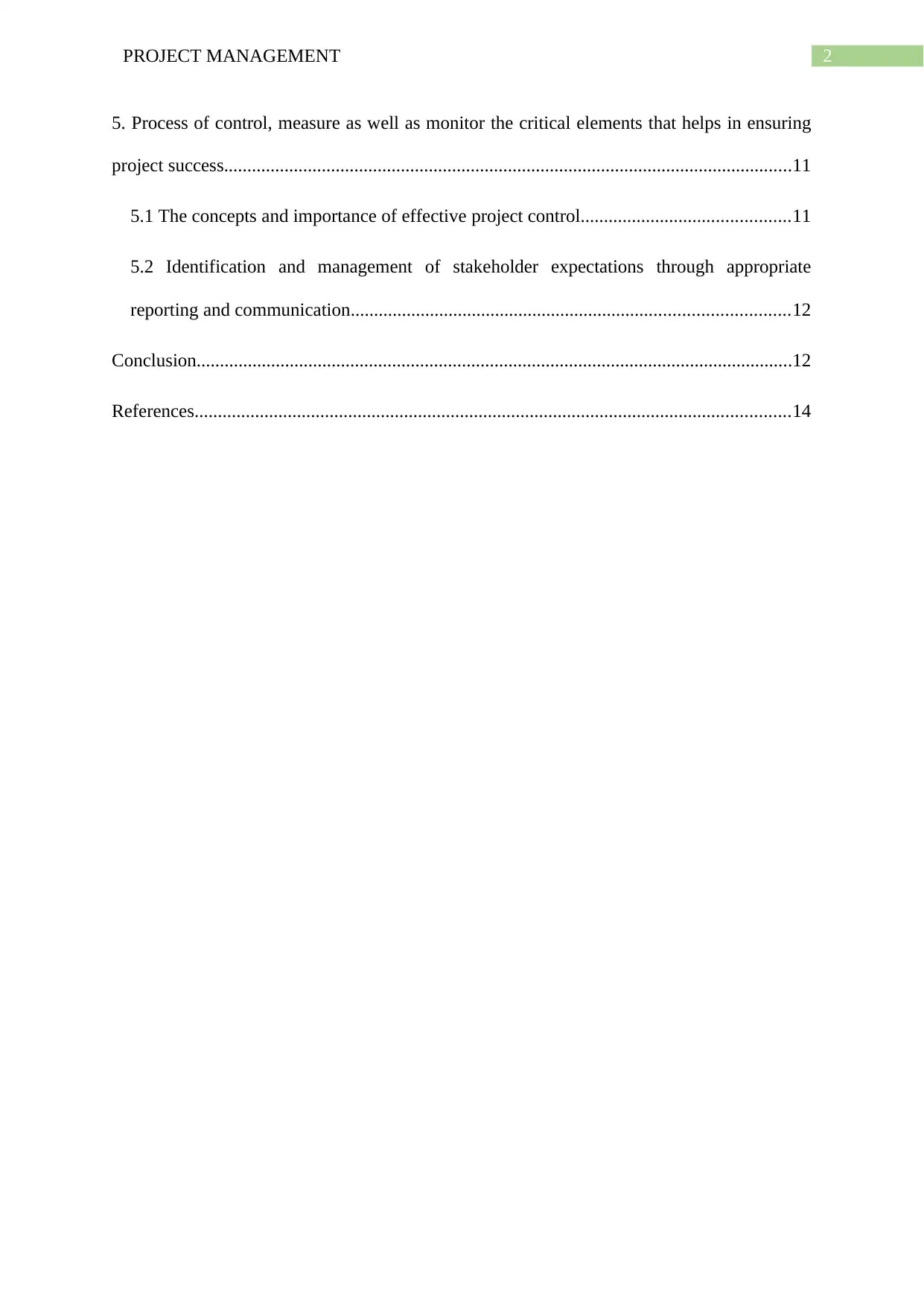
2PROJECT MANAGEMENT
5. Process of control, measure as well as monitor the critical elements that helps in ensuring
project success..........................................................................................................................11
5.1 The concepts and importance of effective project control.............................................11
5.2 Identification and management of stakeholder expectations through appropriate
reporting and communication..............................................................................................12
Conclusion................................................................................................................................12
References................................................................................................................................14
5. Process of control, measure as well as monitor the critical elements that helps in ensuring
project success..........................................................................................................................11
5.1 The concepts and importance of effective project control.............................................11
5.2 Identification and management of stakeholder expectations through appropriate
reporting and communication..............................................................................................12
Conclusion................................................................................................................................12
References................................................................................................................................14
⊘ This is a preview!⊘
Do you want full access?
Subscribe today to unlock all pages.

Trusted by 1+ million students worldwide
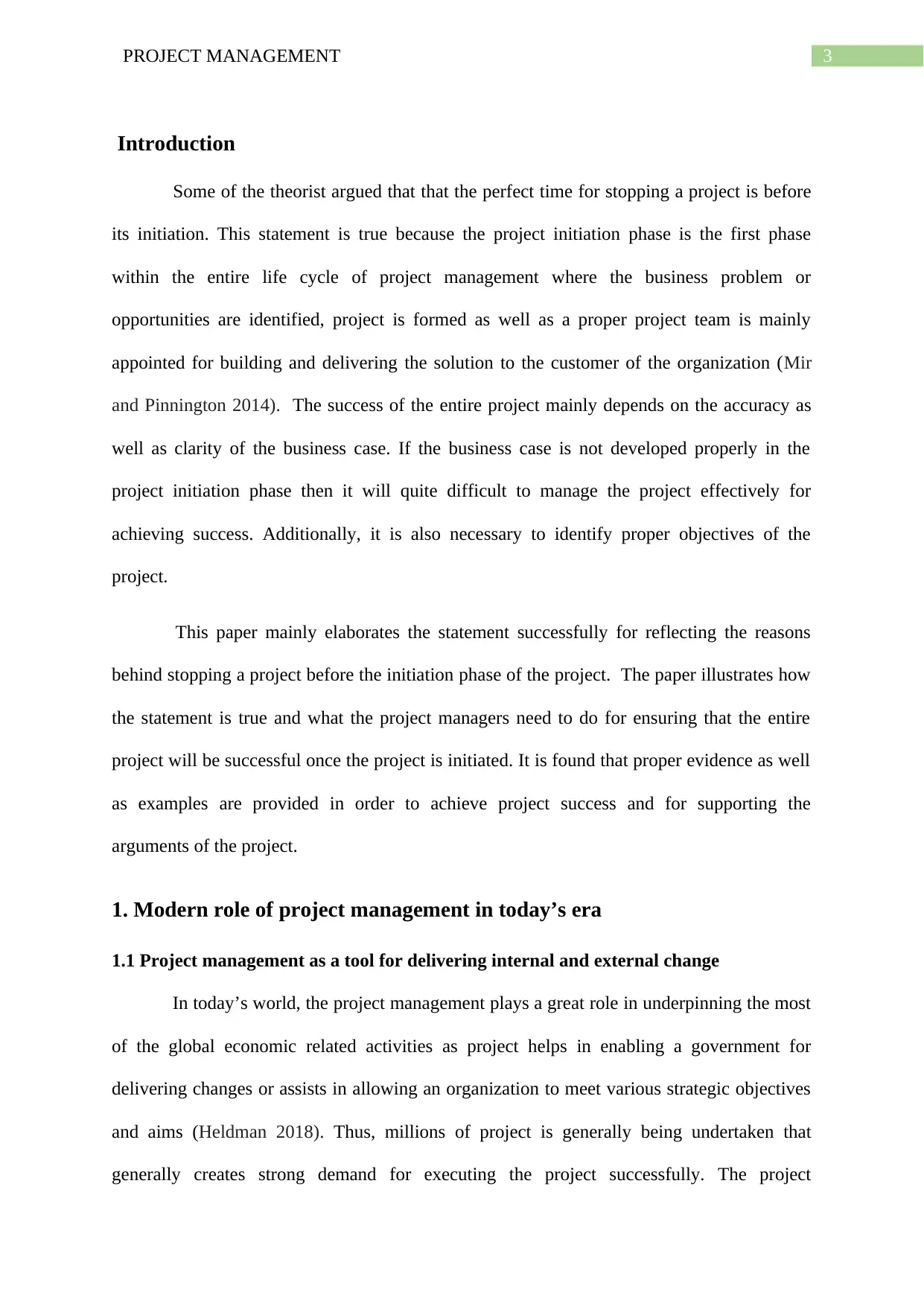
3PROJECT MANAGEMENT
Introduction
Some of the theorist argued that that the perfect time for stopping a project is before
its initiation. This statement is true because the project initiation phase is the first phase
within the entire life cycle of project management where the business problem or
opportunities are identified, project is formed as well as a proper project team is mainly
appointed for building and delivering the solution to the customer of the organization (Mir
and Pinnington 2014). The success of the entire project mainly depends on the accuracy as
well as clarity of the business case. If the business case is not developed properly in the
project initiation phase then it will quite difficult to manage the project effectively for
achieving success. Additionally, it is also necessary to identify proper objectives of the
project.
This paper mainly elaborates the statement successfully for reflecting the reasons
behind stopping a project before the initiation phase of the project. The paper illustrates how
the statement is true and what the project managers need to do for ensuring that the entire
project will be successful once the project is initiated. It is found that proper evidence as well
as examples are provided in order to achieve project success and for supporting the
arguments of the project.
1. Modern role of project management in today’s era
1.1 Project management as a tool for delivering internal and external change
In today’s world, the project management plays a great role in underpinning the most
of the global economic related activities as project helps in enabling a government for
delivering changes or assists in allowing an organization to meet various strategic objectives
and aims (Heldman 2018). Thus, millions of project is generally being undertaken that
generally creates strong demand for executing the project successfully. The project
Introduction
Some of the theorist argued that that the perfect time for stopping a project is before
its initiation. This statement is true because the project initiation phase is the first phase
within the entire life cycle of project management where the business problem or
opportunities are identified, project is formed as well as a proper project team is mainly
appointed for building and delivering the solution to the customer of the organization (Mir
and Pinnington 2014). The success of the entire project mainly depends on the accuracy as
well as clarity of the business case. If the business case is not developed properly in the
project initiation phase then it will quite difficult to manage the project effectively for
achieving success. Additionally, it is also necessary to identify proper objectives of the
project.
This paper mainly elaborates the statement successfully for reflecting the reasons
behind stopping a project before the initiation phase of the project. The paper illustrates how
the statement is true and what the project managers need to do for ensuring that the entire
project will be successful once the project is initiated. It is found that proper evidence as well
as examples are provided in order to achieve project success and for supporting the
arguments of the project.
1. Modern role of project management in today’s era
1.1 Project management as a tool for delivering internal and external change
In today’s world, the project management plays a great role in underpinning the most
of the global economic related activities as project helps in enabling a government for
delivering changes or assists in allowing an organization to meet various strategic objectives
and aims (Heldman 2018). Thus, millions of project is generally being undertaken that
generally creates strong demand for executing the project successfully. The project
Paraphrase This Document
Need a fresh take? Get an instant paraphrase of this document with our AI Paraphraser
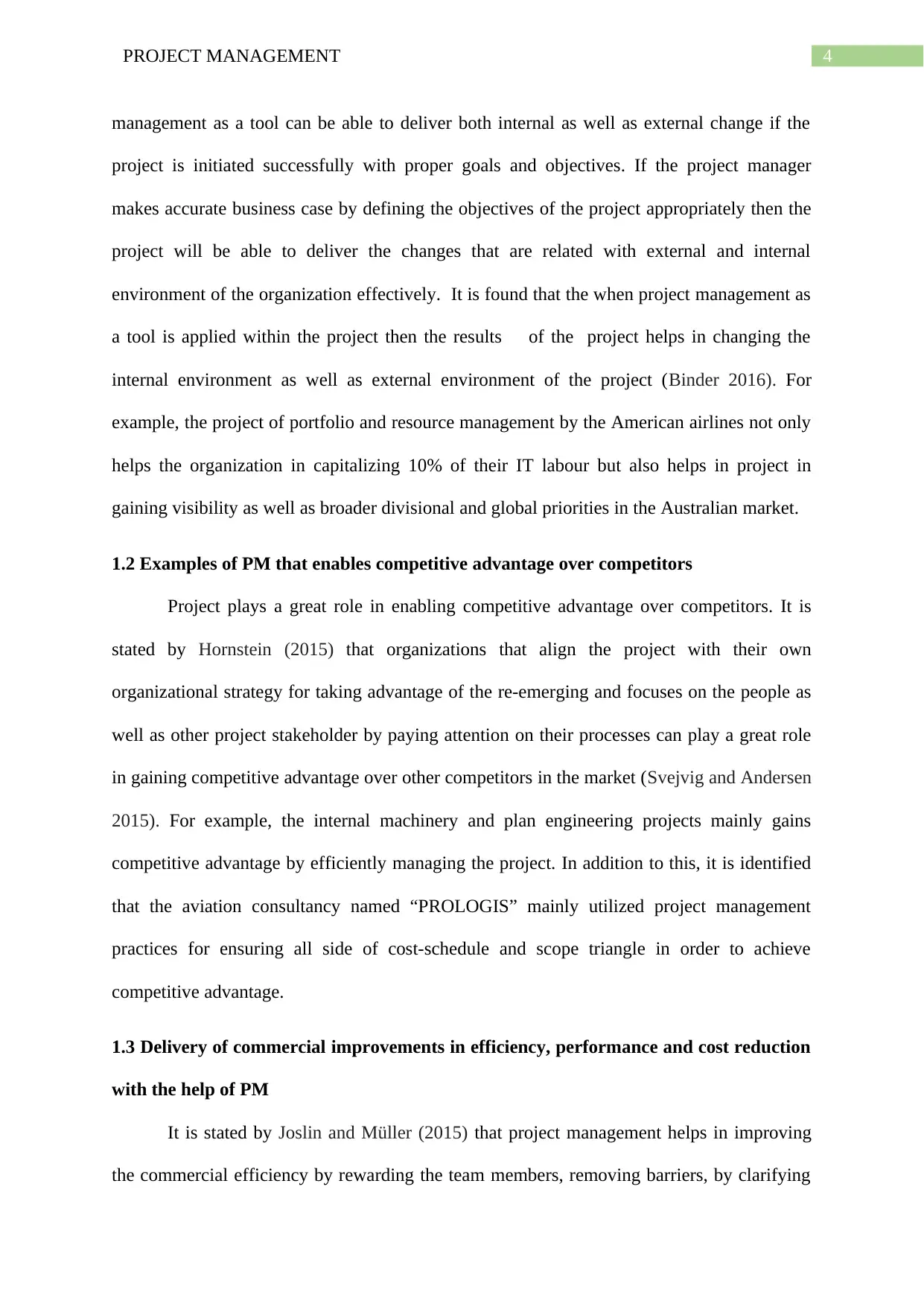
4PROJECT MANAGEMENT
management as a tool can be able to deliver both internal as well as external change if the
project is initiated successfully with proper goals and objectives. If the project manager
makes accurate business case by defining the objectives of the project appropriately then the
project will be able to deliver the changes that are related with external and internal
environment of the organization effectively. It is found that the when project management as
a tool is applied within the project then the results of the project helps in changing the
internal environment as well as external environment of the project (Binder 2016). For
example, the project of portfolio and resource management by the American airlines not only
helps the organization in capitalizing 10% of their IT labour but also helps in project in
gaining visibility as well as broader divisional and global priorities in the Australian market.
1.2 Examples of PM that enables competitive advantage over competitors
Project plays a great role in enabling competitive advantage over competitors. It is
stated by Hornstein (2015) that organizations that align the project with their own
organizational strategy for taking advantage of the re-emerging and focuses on the people as
well as other project stakeholder by paying attention on their processes can play a great role
in gaining competitive advantage over other competitors in the market (Svejvig and Andersen
2015). For example, the internal machinery and plan engineering projects mainly gains
competitive advantage by efficiently managing the project. In addition to this, it is identified
that the aviation consultancy named “PROLOGIS” mainly utilized project management
practices for ensuring all side of cost-schedule and scope triangle in order to achieve
competitive advantage.
1.3 Delivery of commercial improvements in efficiency, performance and cost reduction
with the help of PM
It is stated by Joslin and Müller (2015) that project management helps in improving
the commercial efficiency by rewarding the team members, removing barriers, by clarifying
management as a tool can be able to deliver both internal as well as external change if the
project is initiated successfully with proper goals and objectives. If the project manager
makes accurate business case by defining the objectives of the project appropriately then the
project will be able to deliver the changes that are related with external and internal
environment of the organization effectively. It is found that the when project management as
a tool is applied within the project then the results of the project helps in changing the
internal environment as well as external environment of the project (Binder 2016). For
example, the project of portfolio and resource management by the American airlines not only
helps the organization in capitalizing 10% of their IT labour but also helps in project in
gaining visibility as well as broader divisional and global priorities in the Australian market.
1.2 Examples of PM that enables competitive advantage over competitors
Project plays a great role in enabling competitive advantage over competitors. It is
stated by Hornstein (2015) that organizations that align the project with their own
organizational strategy for taking advantage of the re-emerging and focuses on the people as
well as other project stakeholder by paying attention on their processes can play a great role
in gaining competitive advantage over other competitors in the market (Svejvig and Andersen
2015). For example, the internal machinery and plan engineering projects mainly gains
competitive advantage by efficiently managing the project. In addition to this, it is identified
that the aviation consultancy named “PROLOGIS” mainly utilized project management
practices for ensuring all side of cost-schedule and scope triangle in order to achieve
competitive advantage.
1.3 Delivery of commercial improvements in efficiency, performance and cost reduction
with the help of PM
It is stated by Joslin and Müller (2015) that project management helps in improving
the commercial efficiency by rewarding the team members, removing barriers, by clarifying
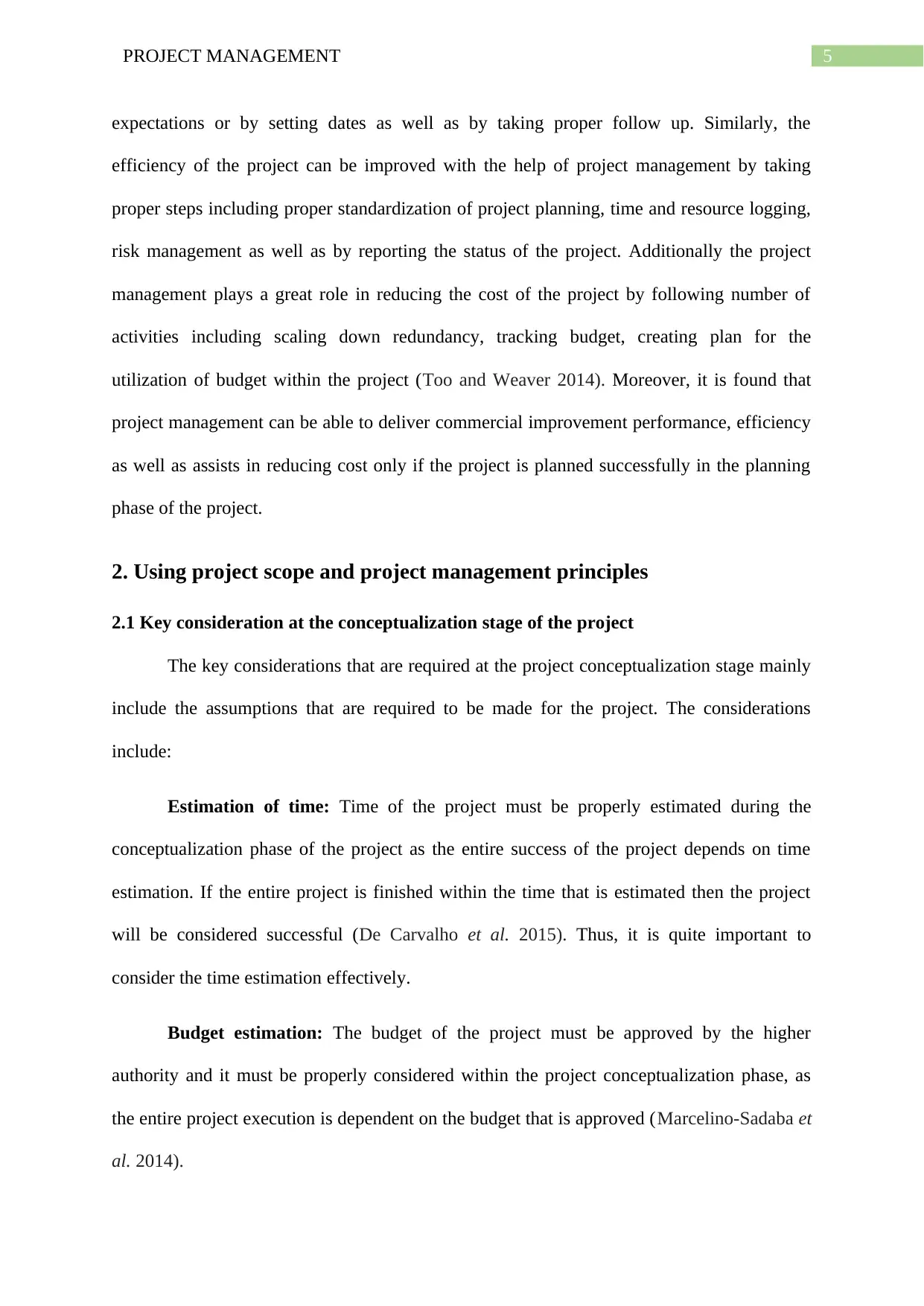
5PROJECT MANAGEMENT
expectations or by setting dates as well as by taking proper follow up. Similarly, the
efficiency of the project can be improved with the help of project management by taking
proper steps including proper standardization of project planning, time and resource logging,
risk management as well as by reporting the status of the project. Additionally the project
management plays a great role in reducing the cost of the project by following number of
activities including scaling down redundancy, tracking budget, creating plan for the
utilization of budget within the project (Too and Weaver 2014). Moreover, it is found that
project management can be able to deliver commercial improvement performance, efficiency
as well as assists in reducing cost only if the project is planned successfully in the planning
phase of the project.
2. Using project scope and project management principles
2.1 Key consideration at the conceptualization stage of the project
The key considerations that are required at the project conceptualization stage mainly
include the assumptions that are required to be made for the project. The considerations
include:
Estimation of time: Time of the project must be properly estimated during the
conceptualization phase of the project as the entire success of the project depends on time
estimation. If the entire project is finished within the time that is estimated then the project
will be considered successful (De Carvalho et al. 2015). Thus, it is quite important to
consider the time estimation effectively.
Budget estimation: The budget of the project must be approved by the higher
authority and it must be properly considered within the project conceptualization phase, as
the entire project execution is dependent on the budget that is approved (Marcelino-Sadaba et
al. 2014).
expectations or by setting dates as well as by taking proper follow up. Similarly, the
efficiency of the project can be improved with the help of project management by taking
proper steps including proper standardization of project planning, time and resource logging,
risk management as well as by reporting the status of the project. Additionally the project
management plays a great role in reducing the cost of the project by following number of
activities including scaling down redundancy, tracking budget, creating plan for the
utilization of budget within the project (Too and Weaver 2014). Moreover, it is found that
project management can be able to deliver commercial improvement performance, efficiency
as well as assists in reducing cost only if the project is planned successfully in the planning
phase of the project.
2. Using project scope and project management principles
2.1 Key consideration at the conceptualization stage of the project
The key considerations that are required at the project conceptualization stage mainly
include the assumptions that are required to be made for the project. The considerations
include:
Estimation of time: Time of the project must be properly estimated during the
conceptualization phase of the project as the entire success of the project depends on time
estimation. If the entire project is finished within the time that is estimated then the project
will be considered successful (De Carvalho et al. 2015). Thus, it is quite important to
consider the time estimation effectively.
Budget estimation: The budget of the project must be approved by the higher
authority and it must be properly considered within the project conceptualization phase, as
the entire project execution is dependent on the budget that is approved (Marcelino-Sadaba et
al. 2014).
⊘ This is a preview!⊘
Do you want full access?
Subscribe today to unlock all pages.

Trusted by 1+ million students worldwide

6PROJECT MANAGEMENT
Analyzing required resources: The resources of the project must be properly
considered so that proper number of project resources can be assigned within the project for
finishing the project within the expected time and budget.
2.2 Ability of writing project charter outlining commercial benefits, high level objectives
It is quite necessary to write a project charter effectively in the initiation phase of the
project that generally outlines various high-level objectives, commercial benefits as well as
estimated ROI. It is found that ability of writing project charter is quite necessary for
achieving success as it generally set out detailed information about project goals, roles and
responsibilities and helps in identifying the main stakeholders who are associated with the
project (Kucharska and Kowalczyk 2016). All this information including the commercial
benefits as well as ROI is necessary for further progress of the project as without this
information the project manager is not able to proceed with the project, which further helps in
creating negative impact on the project.
2.3 Identifying and outlining cost, timeline, quality components and their linkage with
strategic organizational goals.
It is identified that the cost components of the project mainly include investments
costs as well as operating costs. It is very much necessary to link the cost of the project with
the strategic organizational goals so that the project cost can be estimated effectively as per
the project need (Conforto et al. 2014). Similarly, the components that are associated with
timeline include schedule as well as timeline plans and it must be aligned with the strategic
organization goals. This is done for estimating the time of the project as per the project
requirement so that the entire can be finished within the expected deadline (Badewi 2016).In
addition to this, the components of quality planning includes quality planning, quality
assurance, quality control as well as quality control. The quality components must be
Analyzing required resources: The resources of the project must be properly
considered so that proper number of project resources can be assigned within the project for
finishing the project within the expected time and budget.
2.2 Ability of writing project charter outlining commercial benefits, high level objectives
It is quite necessary to write a project charter effectively in the initiation phase of the
project that generally outlines various high-level objectives, commercial benefits as well as
estimated ROI. It is found that ability of writing project charter is quite necessary for
achieving success as it generally set out detailed information about project goals, roles and
responsibilities and helps in identifying the main stakeholders who are associated with the
project (Kucharska and Kowalczyk 2016). All this information including the commercial
benefits as well as ROI is necessary for further progress of the project as without this
information the project manager is not able to proceed with the project, which further helps in
creating negative impact on the project.
2.3 Identifying and outlining cost, timeline, quality components and their linkage with
strategic organizational goals.
It is identified that the cost components of the project mainly include investments
costs as well as operating costs. It is very much necessary to link the cost of the project with
the strategic organizational goals so that the project cost can be estimated effectively as per
the project need (Conforto et al. 2014). Similarly, the components that are associated with
timeline include schedule as well as timeline plans and it must be aligned with the strategic
organization goals. This is done for estimating the time of the project as per the project
requirement so that the entire can be finished within the expected deadline (Badewi 2016).In
addition to this, the components of quality planning includes quality planning, quality
assurance, quality control as well as quality control. The quality components must be
Paraphrase This Document
Need a fresh take? Get an instant paraphrase of this document with our AI Paraphraser
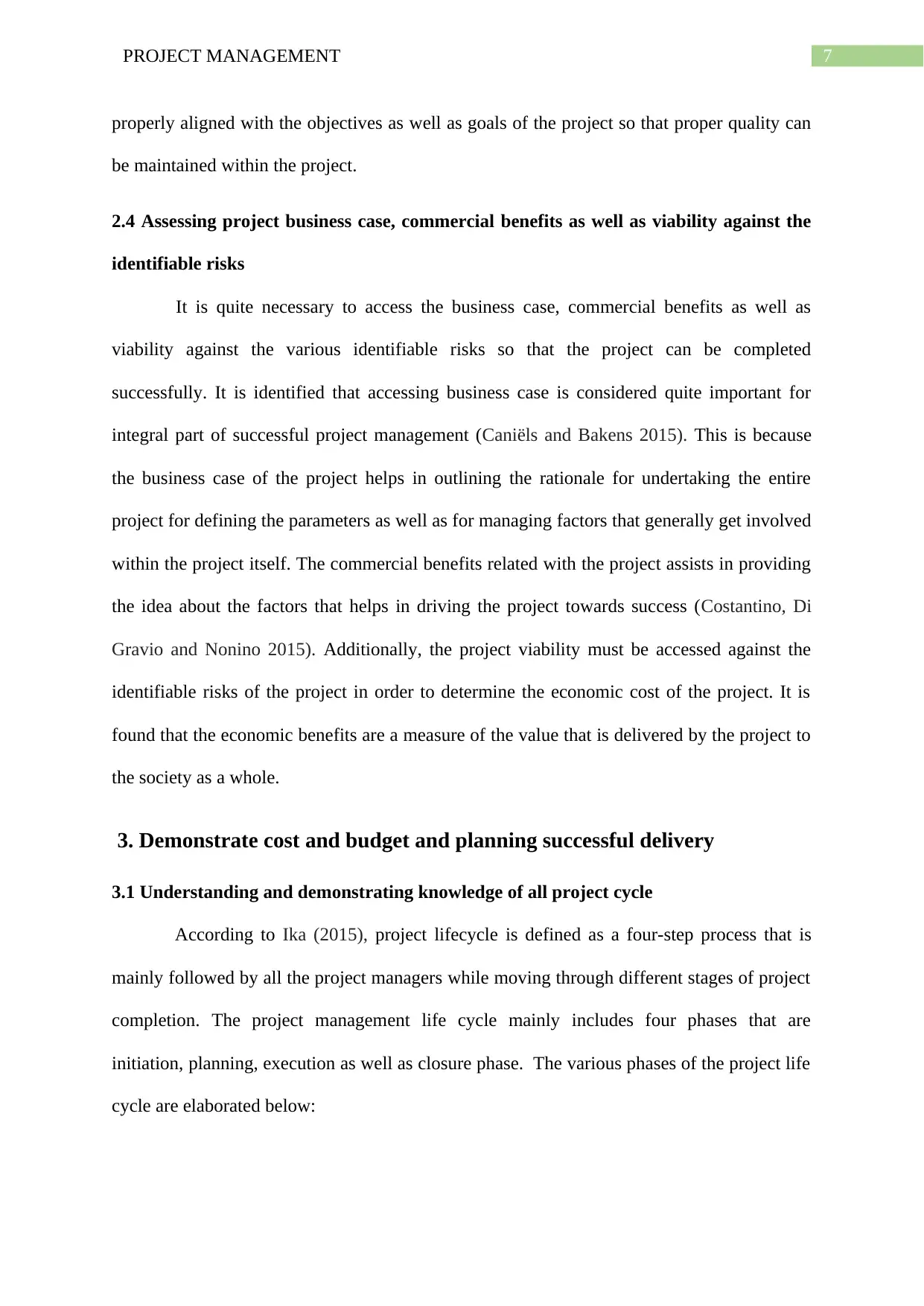
7PROJECT MANAGEMENT
properly aligned with the objectives as well as goals of the project so that proper quality can
be maintained within the project.
2.4 Assessing project business case, commercial benefits as well as viability against the
identifiable risks
It is quite necessary to access the business case, commercial benefits as well as
viability against the various identifiable risks so that the project can be completed
successfully. It is identified that accessing business case is considered quite important for
integral part of successful project management (Caniëls and Bakens 2015). This is because
the business case of the project helps in outlining the rationale for undertaking the entire
project for defining the parameters as well as for managing factors that generally get involved
within the project itself. The commercial benefits related with the project assists in providing
the idea about the factors that helps in driving the project towards success (Costantino, Di
Gravio and Nonino 2015). Additionally, the project viability must be accessed against the
identifiable risks of the project in order to determine the economic cost of the project. It is
found that the economic benefits are a measure of the value that is delivered by the project to
the society as a whole.
3. Demonstrate cost and budget and planning successful delivery
3.1 Understanding and demonstrating knowledge of all project cycle
According to Ika (2015), project lifecycle is defined as a four-step process that is
mainly followed by all the project managers while moving through different stages of project
completion. The project management life cycle mainly includes four phases that are
initiation, planning, execution as well as closure phase. The various phases of the project life
cycle are elaborated below:
properly aligned with the objectives as well as goals of the project so that proper quality can
be maintained within the project.
2.4 Assessing project business case, commercial benefits as well as viability against the
identifiable risks
It is quite necessary to access the business case, commercial benefits as well as
viability against the various identifiable risks so that the project can be completed
successfully. It is identified that accessing business case is considered quite important for
integral part of successful project management (Caniëls and Bakens 2015). This is because
the business case of the project helps in outlining the rationale for undertaking the entire
project for defining the parameters as well as for managing factors that generally get involved
within the project itself. The commercial benefits related with the project assists in providing
the idea about the factors that helps in driving the project towards success (Costantino, Di
Gravio and Nonino 2015). Additionally, the project viability must be accessed against the
identifiable risks of the project in order to determine the economic cost of the project. It is
found that the economic benefits are a measure of the value that is delivered by the project to
the society as a whole.
3. Demonstrate cost and budget and planning successful delivery
3.1 Understanding and demonstrating knowledge of all project cycle
According to Ika (2015), project lifecycle is defined as a four-step process that is
mainly followed by all the project managers while moving through different stages of project
completion. The project management life cycle mainly includes four phases that are
initiation, planning, execution as well as closure phase. The various phases of the project life
cycle are elaborated below:
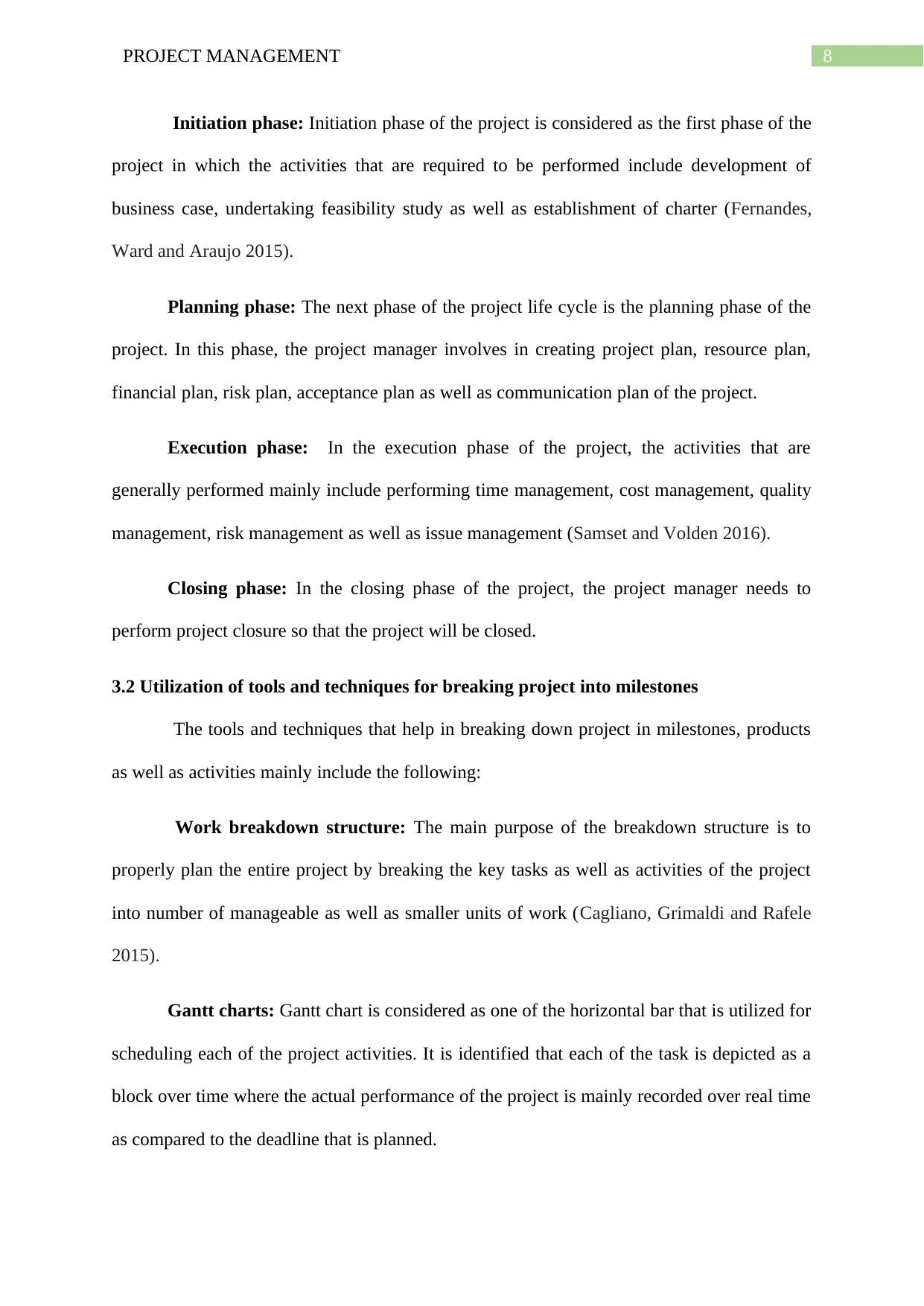
8PROJECT MANAGEMENT
Initiation phase: Initiation phase of the project is considered as the first phase of the
project in which the activities that are required to be performed include development of
business case, undertaking feasibility study as well as establishment of charter (Fernandes,
Ward and Araujo 2015).
Planning phase: The next phase of the project life cycle is the planning phase of the
project. In this phase, the project manager involves in creating project plan, resource plan,
financial plan, risk plan, acceptance plan as well as communication plan of the project.
Execution phase: In the execution phase of the project, the activities that are
generally performed mainly include performing time management, cost management, quality
management, risk management as well as issue management (Samset and Volden 2016).
Closing phase: In the closing phase of the project, the project manager needs to
perform project closure so that the project will be closed.
3.2 Utilization of tools and techniques for breaking project into milestones
The tools and techniques that help in breaking down project in milestones, products
as well as activities mainly include the following:
Work breakdown structure: The main purpose of the breakdown structure is to
properly plan the entire project by breaking the key tasks as well as activities of the project
into number of manageable as well as smaller units of work (Cagliano, Grimaldi and Rafele
2015).
Gantt charts: Gantt chart is considered as one of the horizontal bar that is utilized for
scheduling each of the project activities. It is identified that each of the task is depicted as a
block over time where the actual performance of the project is mainly recorded over real time
as compared to the deadline that is planned.
Initiation phase: Initiation phase of the project is considered as the first phase of the
project in which the activities that are required to be performed include development of
business case, undertaking feasibility study as well as establishment of charter (Fernandes,
Ward and Araujo 2015).
Planning phase: The next phase of the project life cycle is the planning phase of the
project. In this phase, the project manager involves in creating project plan, resource plan,
financial plan, risk plan, acceptance plan as well as communication plan of the project.
Execution phase: In the execution phase of the project, the activities that are
generally performed mainly include performing time management, cost management, quality
management, risk management as well as issue management (Samset and Volden 2016).
Closing phase: In the closing phase of the project, the project manager needs to
perform project closure so that the project will be closed.
3.2 Utilization of tools and techniques for breaking project into milestones
The tools and techniques that help in breaking down project in milestones, products
as well as activities mainly include the following:
Work breakdown structure: The main purpose of the breakdown structure is to
properly plan the entire project by breaking the key tasks as well as activities of the project
into number of manageable as well as smaller units of work (Cagliano, Grimaldi and Rafele
2015).
Gantt charts: Gantt chart is considered as one of the horizontal bar that is utilized for
scheduling each of the project activities. It is identified that each of the task is depicted as a
block over time where the actual performance of the project is mainly recorded over real time
as compared to the deadline that is planned.
⊘ This is a preview!⊘
Do you want full access?
Subscribe today to unlock all pages.

Trusted by 1+ million students worldwide
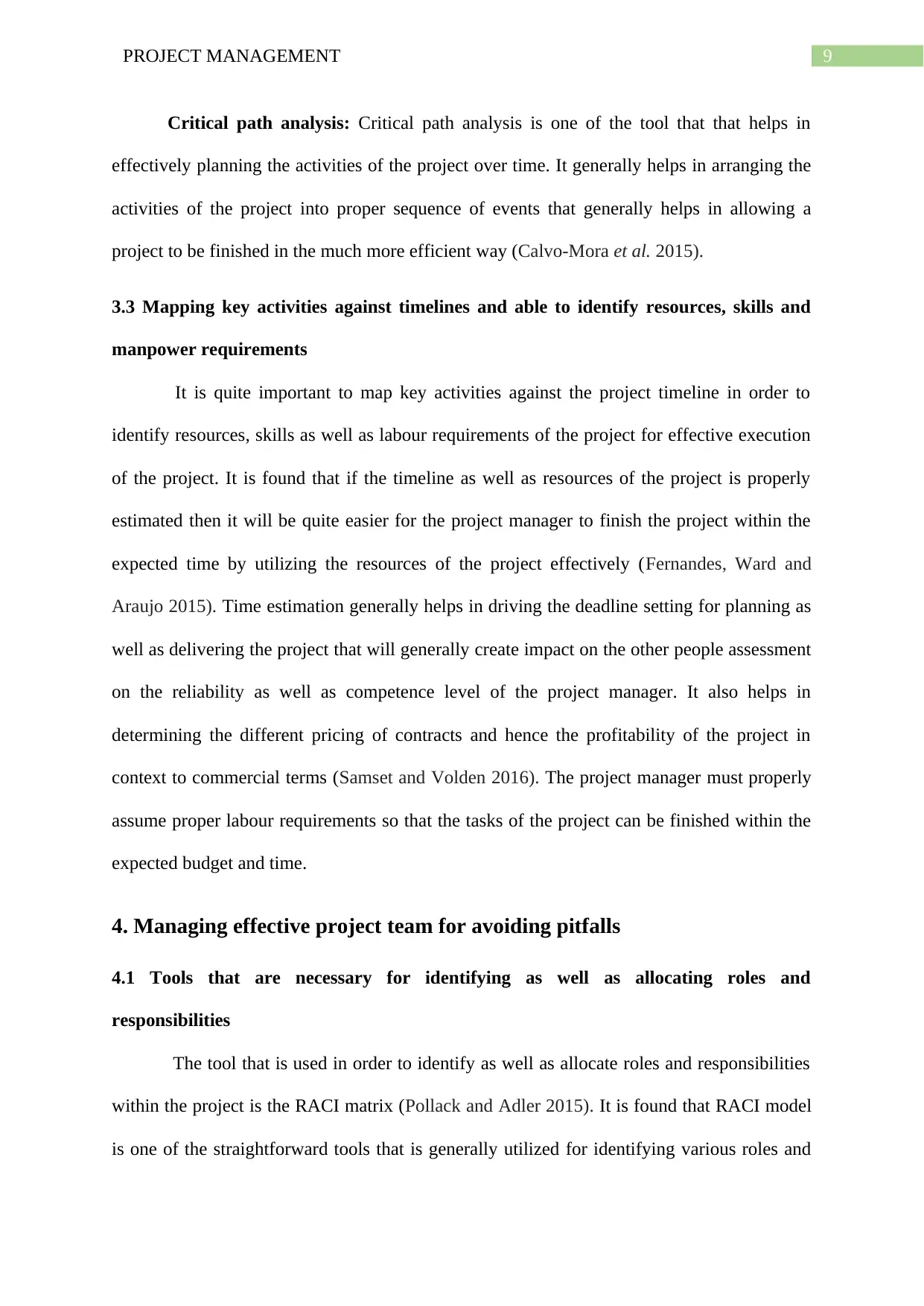
9PROJECT MANAGEMENT
Critical path analysis: Critical path analysis is one of the tool that that helps in
effectively planning the activities of the project over time. It generally helps in arranging the
activities of the project into proper sequence of events that generally helps in allowing a
project to be finished in the much more efficient way (Calvo-Mora et al. 2015).
3.3 Mapping key activities against timelines and able to identify resources, skills and
manpower requirements
It is quite important to map key activities against the project timeline in order to
identify resources, skills as well as labour requirements of the project for effective execution
of the project. It is found that if the timeline as well as resources of the project is properly
estimated then it will be quite easier for the project manager to finish the project within the
expected time by utilizing the resources of the project effectively (Fernandes, Ward and
Araujo 2015). Time estimation generally helps in driving the deadline setting for planning as
well as delivering the project that will generally create impact on the other people assessment
on the reliability as well as competence level of the project manager. It also helps in
determining the different pricing of contracts and hence the profitability of the project in
context to commercial terms (Samset and Volden 2016). The project manager must properly
assume proper labour requirements so that the tasks of the project can be finished within the
expected budget and time.
4. Managing effective project team for avoiding pitfalls
4.1 Tools that are necessary for identifying as well as allocating roles and
responsibilities
The tool that is used in order to identify as well as allocate roles and responsibilities
within the project is the RACI matrix (Pollack and Adler 2015). It is found that RACI model
is one of the straightforward tools that is generally utilized for identifying various roles and
Critical path analysis: Critical path analysis is one of the tool that that helps in
effectively planning the activities of the project over time. It generally helps in arranging the
activities of the project into proper sequence of events that generally helps in allowing a
project to be finished in the much more efficient way (Calvo-Mora et al. 2015).
3.3 Mapping key activities against timelines and able to identify resources, skills and
manpower requirements
It is quite important to map key activities against the project timeline in order to
identify resources, skills as well as labour requirements of the project for effective execution
of the project. It is found that if the timeline as well as resources of the project is properly
estimated then it will be quite easier for the project manager to finish the project within the
expected time by utilizing the resources of the project effectively (Fernandes, Ward and
Araujo 2015). Time estimation generally helps in driving the deadline setting for planning as
well as delivering the project that will generally create impact on the other people assessment
on the reliability as well as competence level of the project manager. It also helps in
determining the different pricing of contracts and hence the profitability of the project in
context to commercial terms (Samset and Volden 2016). The project manager must properly
assume proper labour requirements so that the tasks of the project can be finished within the
expected budget and time.
4. Managing effective project team for avoiding pitfalls
4.1 Tools that are necessary for identifying as well as allocating roles and
responsibilities
The tool that is used in order to identify as well as allocate roles and responsibilities
within the project is the RACI matrix (Pollack and Adler 2015). It is found that RACI model
is one of the straightforward tools that is generally utilized for identifying various roles and
Paraphrase This Document
Need a fresh take? Get an instant paraphrase of this document with our AI Paraphraser
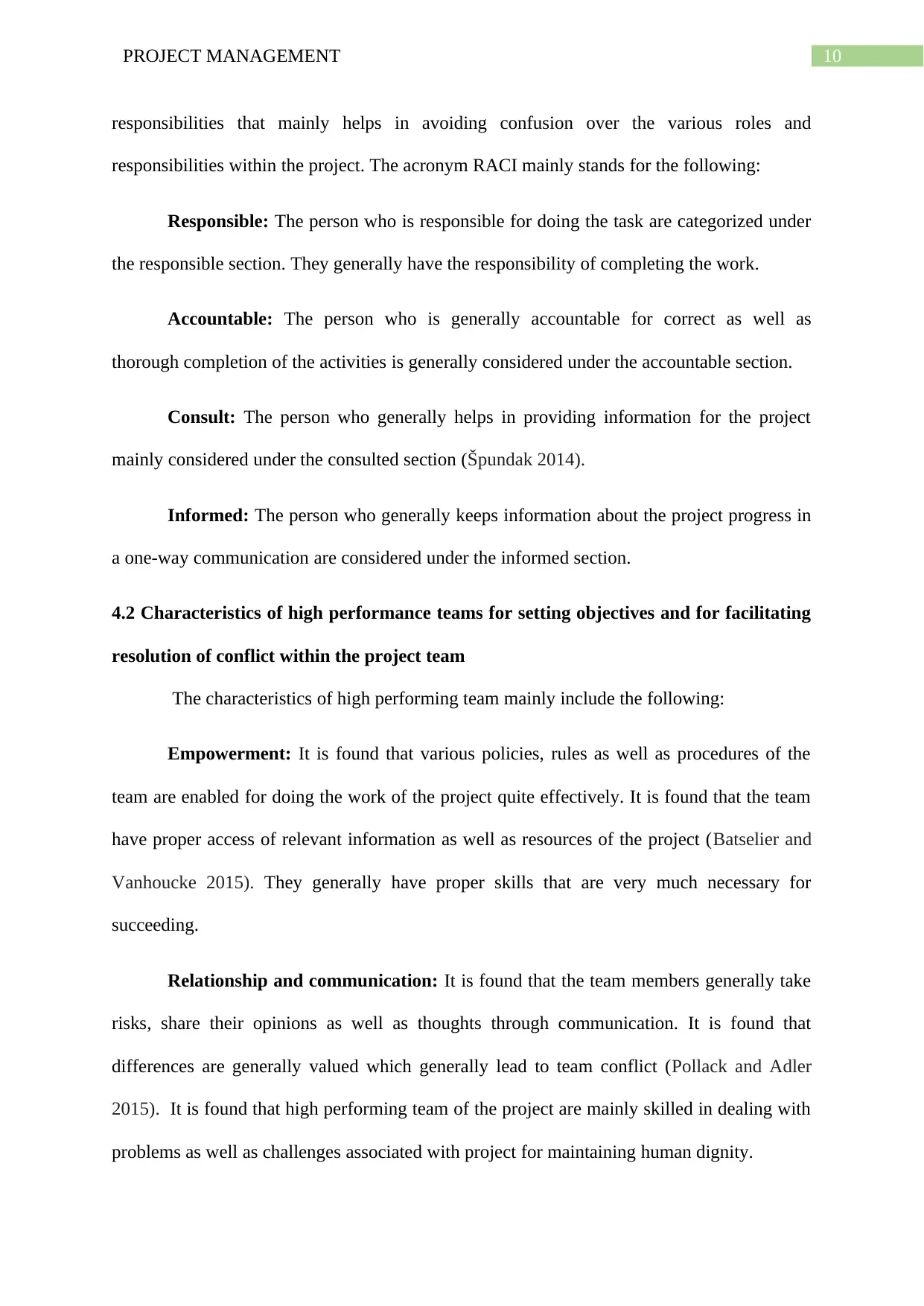
10PROJECT MANAGEMENT
responsibilities that mainly helps in avoiding confusion over the various roles and
responsibilities within the project. The acronym RACI mainly stands for the following:
Responsible: The person who is responsible for doing the task are categorized under
the responsible section. They generally have the responsibility of completing the work.
Accountable: The person who is generally accountable for correct as well as
thorough completion of the activities is generally considered under the accountable section.
Consult: The person who generally helps in providing information for the project
mainly considered under the consulted section (Špundak 2014).
Informed: The person who generally keeps information about the project progress in
a one-way communication are considered under the informed section.
4.2 Characteristics of high performance teams for setting objectives and for facilitating
resolution of conflict within the project team
The characteristics of high performing team mainly include the following:
Empowerment: It is found that various policies, rules as well as procedures of the
team are enabled for doing the work of the project quite effectively. It is found that the team
have proper access of relevant information as well as resources of the project (Batselier and
Vanhoucke 2015). They generally have proper skills that are very much necessary for
succeeding.
Relationship and communication: It is found that the team members generally take
risks, share their opinions as well as thoughts through communication. It is found that
differences are generally valued which generally lead to team conflict (Pollack and Adler
2015). It is found that high performing team of the project are mainly skilled in dealing with
problems as well as challenges associated with project for maintaining human dignity.
responsibilities that mainly helps in avoiding confusion over the various roles and
responsibilities within the project. The acronym RACI mainly stands for the following:
Responsible: The person who is responsible for doing the task are categorized under
the responsible section. They generally have the responsibility of completing the work.
Accountable: The person who is generally accountable for correct as well as
thorough completion of the activities is generally considered under the accountable section.
Consult: The person who generally helps in providing information for the project
mainly considered under the consulted section (Špundak 2014).
Informed: The person who generally keeps information about the project progress in
a one-way communication are considered under the informed section.
4.2 Characteristics of high performance teams for setting objectives and for facilitating
resolution of conflict within the project team
The characteristics of high performing team mainly include the following:
Empowerment: It is found that various policies, rules as well as procedures of the
team are enabled for doing the work of the project quite effectively. It is found that the team
have proper access of relevant information as well as resources of the project (Batselier and
Vanhoucke 2015). They generally have proper skills that are very much necessary for
succeeding.
Relationship and communication: It is found that the team members generally take
risks, share their opinions as well as thoughts through communication. It is found that
differences are generally valued which generally lead to team conflict (Pollack and Adler
2015). It is found that high performing team of the project are mainly skilled in dealing with
problems as well as challenges associated with project for maintaining human dignity.
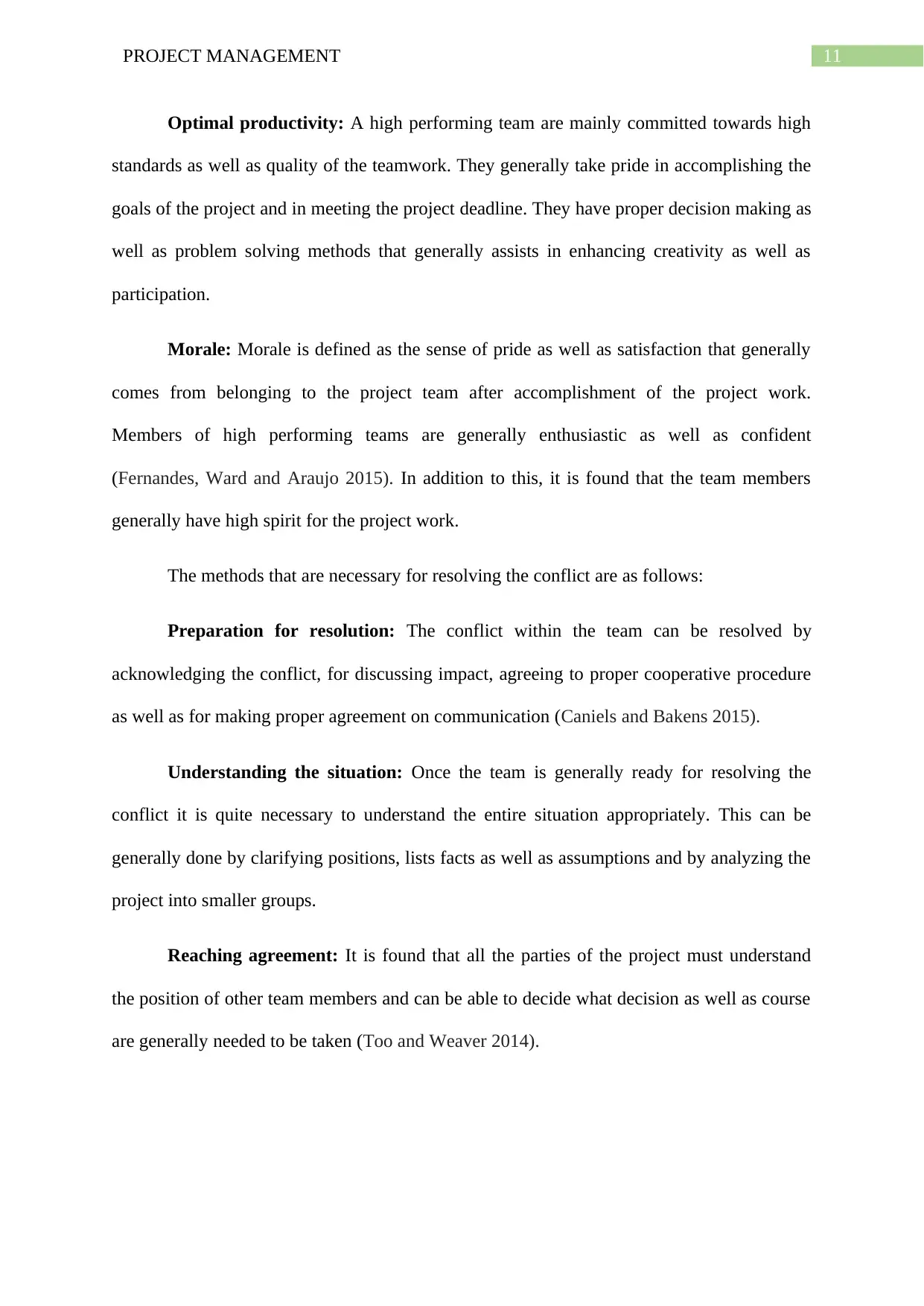
11PROJECT MANAGEMENT
Optimal productivity: A high performing team are mainly committed towards high
standards as well as quality of the teamwork. They generally take pride in accomplishing the
goals of the project and in meeting the project deadline. They have proper decision making as
well as problem solving methods that generally assists in enhancing creativity as well as
participation.
Morale: Morale is defined as the sense of pride as well as satisfaction that generally
comes from belonging to the project team after accomplishment of the project work.
Members of high performing teams are generally enthusiastic as well as confident
(Fernandes, Ward and Araujo 2015). In addition to this, it is found that the team members
generally have high spirit for the project work.
The methods that are necessary for resolving the conflict are as follows:
Preparation for resolution: The conflict within the team can be resolved by
acknowledging the conflict, for discussing impact, agreeing to proper cooperative procedure
as well as for making proper agreement on communication (Caniels and Bakens 2015).
Understanding the situation: Once the team is generally ready for resolving the
conflict it is quite necessary to understand the entire situation appropriately. This can be
generally done by clarifying positions, lists facts as well as assumptions and by analyzing the
project into smaller groups.
Reaching agreement: It is found that all the parties of the project must understand
the position of other team members and can be able to decide what decision as well as course
are generally needed to be taken (Too and Weaver 2014).
Optimal productivity: A high performing team are mainly committed towards high
standards as well as quality of the teamwork. They generally take pride in accomplishing the
goals of the project and in meeting the project deadline. They have proper decision making as
well as problem solving methods that generally assists in enhancing creativity as well as
participation.
Morale: Morale is defined as the sense of pride as well as satisfaction that generally
comes from belonging to the project team after accomplishment of the project work.
Members of high performing teams are generally enthusiastic as well as confident
(Fernandes, Ward and Araujo 2015). In addition to this, it is found that the team members
generally have high spirit for the project work.
The methods that are necessary for resolving the conflict are as follows:
Preparation for resolution: The conflict within the team can be resolved by
acknowledging the conflict, for discussing impact, agreeing to proper cooperative procedure
as well as for making proper agreement on communication (Caniels and Bakens 2015).
Understanding the situation: Once the team is generally ready for resolving the
conflict it is quite necessary to understand the entire situation appropriately. This can be
generally done by clarifying positions, lists facts as well as assumptions and by analyzing the
project into smaller groups.
Reaching agreement: It is found that all the parties of the project must understand
the position of other team members and can be able to decide what decision as well as course
are generally needed to be taken (Too and Weaver 2014).
⊘ This is a preview!⊘
Do you want full access?
Subscribe today to unlock all pages.

Trusted by 1+ million students worldwide
1 out of 17
Related Documents
Your All-in-One AI-Powered Toolkit for Academic Success.
+13062052269
info@desklib.com
Available 24*7 on WhatsApp / Email
![[object Object]](/_next/static/media/star-bottom.7253800d.svg)
Unlock your academic potential
Copyright © 2020–2025 A2Z Services. All Rights Reserved. Developed and managed by ZUCOL.




